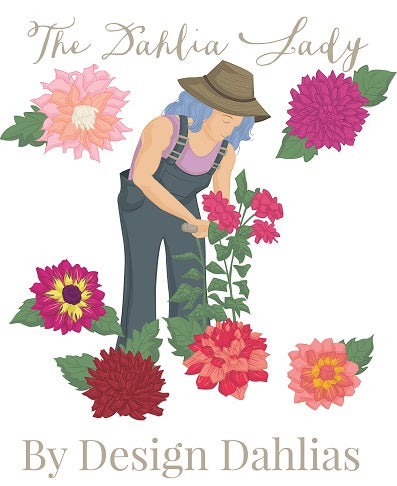How To
Planting and Growing Your New Dahlia Tuber!
Step 1 – prep the bed
After the last hard frost, find a sunny spot that can support a good sized bush. Dig a large hole in the ground – 18-24 inches deep and wide. If soil is hard packed or clay, lighten it with some peat moss or potting soil. If sandy, add top soil. Kitchen compost is ok in moderation, but NO COW MANURE! Replace loose, loamy soil until the hole is only 3 inches deep. Work half of one bag of ‘Emily’s Dahlia Gro’ (or one cup of low nitrogen bulb food) into the loose soil. Add 1 inch of unfertilized soil to the top of this bed, and put the remaining fertilizer in a ring around the edge of the hole, working it in and under, creating a nest for the tuber, with the center lying in unfertilized dirt. (see figure). This allows the tuber to begin to generate in low nitrogen soil, which encourages flower growth, but the ‘nest’ or ‘ring’ of rich soil draws the roots out, for better tuber generation.
Step 2 – plant the tuber
Gently remove the label tape from neck of tuber, and place it in the ground at a 45 degree angle, so it is anchored in soil, but the ‘eye’ or sprout gets plenty of light. ‘Eyes’ are always located near the area that was a stem last year. Whether you see an eye or not, (Emily’s tubers are guaranteed to have at least one!) the top of the tuber cannot be deeper than 1 ½ - 2 inches in order to grow. If they are too deep, they will not know enough to grow up. Add label and stake on the North side of the tuber, so you know where to look for the budding ‘nose’, and bring the soil up to level, lightly covering any sprouts that have emerged in the bag so they don’t get sunburned.
Do not mulch. Dahlias like the sun on their toes in the dirt, and slugs will nibble dahlia noses before you even see them. Do not fertilize your dahlias after this initial bedding preparation. Your nest will provide all they need. Too much fertilizer gives a leafy bush with no flowers. Planting too deep or too late in season will have a similar result. Do not water initially; water only during droughts in the summer, and then water deeply, not daily.
Cut flowers
Dahlias LOVE to have their flowers cut. The more you cut them, the more they will flower. I have achieved 40 flowers per plant by regularly removing each flower as it comes into bloom. Bouquets make lovely gifts.
Fall digging
It is critical to let a frost hit the plants, maybe even two; enough to kill off the foliage, and let the good go back into the tubers. Do not let the tubers freeze, at any point, or that's the end of them. Dig up the tuber clumps carefully; you will be amazed how big they have become. Wash the soil off thoroughly, and let dry overnight indoors. Now is a good time to split the tubers. Each tuber, or tuber grouping MUST have at least one 'eye', or it will not grow. 'Eyes' are easier to see in spring, but are more sensitive to damage then as well. ‘Eyes’ are located at the base of the stem, if the stem is split so that a piece of stem accompanies each tuber, there should be no problem. An antifungal powder or spray should help prevent mold growth if this should be an issue.
Winter storage
Dahlias cannot dry out completely, and yet neither should they get so wet they rot. They must be cold; (less than 52 degrees) and yet they cannot freeze. Slightly dampened cedar chips (animal bedding) works beautifully. Storage in a black plastic garbage bag keeps out light, but many holes punched in the plastic is critical so tubers can breath. Cold storage may be hard to find in modern basements, but there is usually a cold corner up against the cement wall, and blankets over a box may insulate against warm air.
Digging and storage sound like too much work? Let them rot! Come see me again next year at the Norwich Farmer’s Market the last two Saturdays in May for more tubers or new colors!
